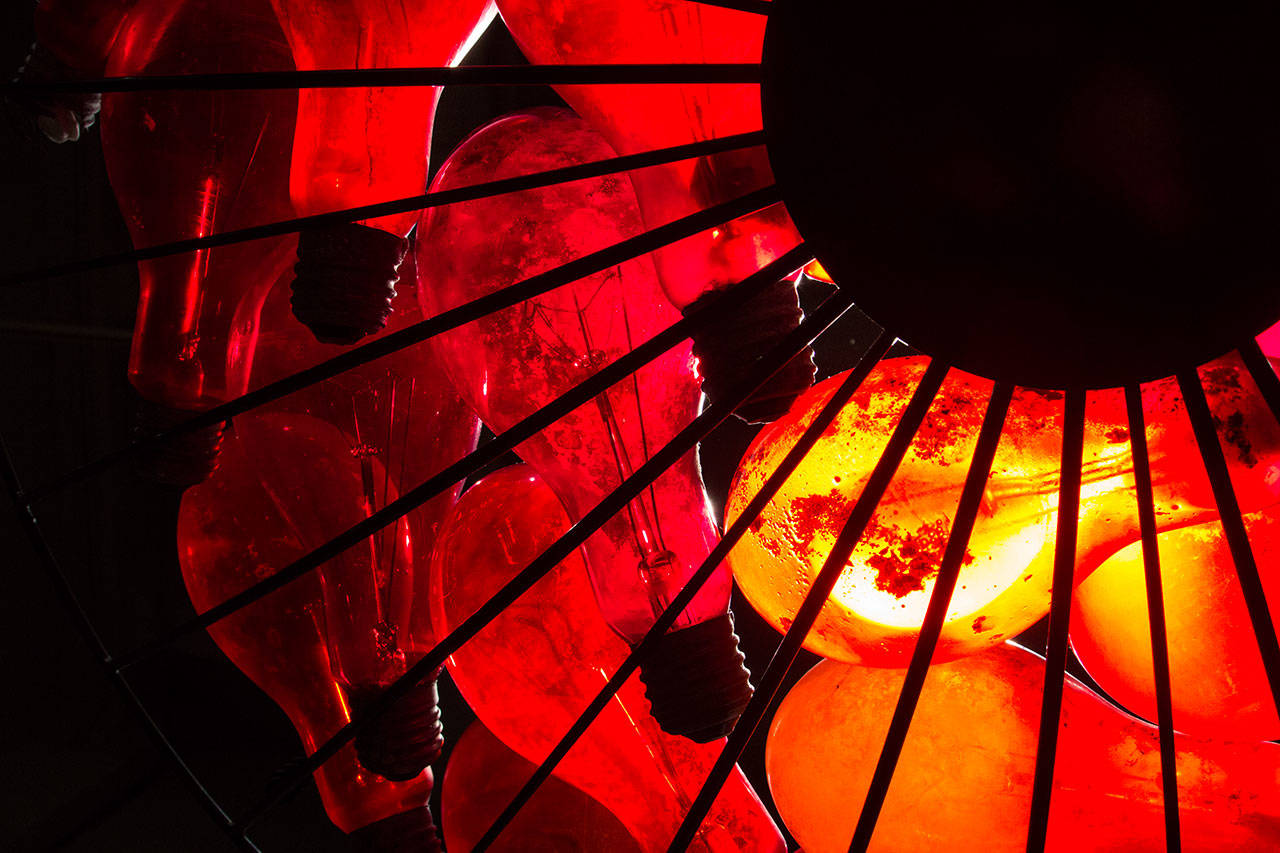Feeling small and helpless against the looming issue of global warming, April Surgent began working with scientists to learn more about environmental issues and using art as a platform to inspire change.
“Plastics are certainly one of the top threats to the oceans,” Surgent said, noting that by 2050 scientists estimate there will be more plastic in the ocean than fish. These days, she added, researchers say approximately 90 percent of table salt contains plastic.
The exhibit at the San Juan Islands Museum of Art runs until Dec. 10. Museum hours are 11 a.m.-5 p.m., Friday through Monday. Admission fees are $10 for adults and free for children under 18. Mondays are “pay what you can.” The exhibit will move to the Schack Art Center in Everett, Washington, Jan. 10 through Feb. 23, however, and there will be a reception at the center 5-8 p.m. on Jan. 17.
Volunteering as a wildlife biologist to study the endangered monk seals, Surgent saw the North Pacific gyre, or circular current, up close. The gyre, also known as the Great Pacific Garbage Patch, is a swath of trash, mostly plastic, that is now larger than the state of Texas. Plastics imperil monk seals through entanglement and ingestion, according to Surgent. Entanglement is the higher danger, usually from nets caught along coral reefs. Trash washes up daily along shorelines where the seals nurse. The pups play and chew on various plastic objects they find the way a puppy plays with dog toys, she said, which is often when ingestion occurs.
“My biggest takeaway from the study was how important our individual actions are,” Surgent said, explaining that one type of plastic is not the culprit, but rather thousands of everyday items like brown prescription bottles, lighters, Croc shoes, grocery bags, toothbrushes, potty training seats even port-a-potty doors.
“These were things I personally have used, and I thought to myself how do I know that a lighter for example, that I used isn’t out there,” Surgent said, “I don’t. We throw things in the trash, but after that, we don’t know. So it became very apparent to me how our individual actions are impacting the environment.”
Surgent comes from a family of woodworkers, so art, she said, came naturally. Her family also sailed frequently around the San Juan Islands, Surgent noted, making her familiar with the waters surrounding the area.
Now frequently working with art and science, Surgent says the two worlds are connected. Both artists and scientists are seeking the same goals, asking similar questions, like how does the world work and what is their place in it; they just process them differently. A scientist, for example, examines their hypothesis through experiments and testing. An artist, on the other hand, expresses their thoughts through their chosen art medium.
People viewing her work have had the mistaken impression she used items from cargo spills or similar catastrophes. It is difficult to fathom that she acquired the wall of over 2,000 lighters for her piece “All the little things” from the beach, or that the metal basket full of blood red lightbulbs in “Bycatch” all washed up from the sea. People cannot comprehend the sheer volume of trash generated by their own hands.
“The fishing industry is responsible for a large portion, the nets, and I suspect the lightbulbs too. I would say at least 50 percent of it, however, is from consumers,” said Surgent.
She is not completely pessimistic, however.
“We can do it, it will take a lot of work, but we can do it,” she said, proceeding to tell the story of a Hawaiian nonprofit that cleans beaches. Not long after they clean the beaches, more waste washes up, frustrating volunteers, but highlighting how massive the problem has become.
Surgent tries to cut disposable items out of her life but often comes away from the grocery store feeling defeated by plastic food packaging.
“The biggest thing is to really think about our consumer decisions and make even small choices toward positive impacts rather than destructive ones,” she explained. That one tub of cottage cheese, for example, might not make a difference, however, there are billions of people in the world and probably tons of plastic cottage cheese containers floating in the sea. Once people take those small steps, buying more consciously, they may be inclined to take larger actions, like cleaning up their favorite beach.
“It’s true that if the oceans die, we die and the oceans are really sick right now,” Surgent said, explaining that at least 50 percent of the oxygen humans breathe comes from the oceans, due in part to tiny plants called phytoplankton.
She warned it’s easy to get distracted and overwhelmed by the statistics of struggling marine life, waters rising and warming, and miss the bigger picture of what it means that an entire ecosystem is on the verge of collapse.
“Being a deer in headlights, though, won’t create change,” Surgent said, “Sometimes I feel so small. I wonder how am I ever going to reach anyone,” she said. However, Surgent continued, people communicate with one another, words spread and those words can build into real positive change.
“It is like an army of small actions that hopefully will make an impact.”
For more information, visit sjima.org.



